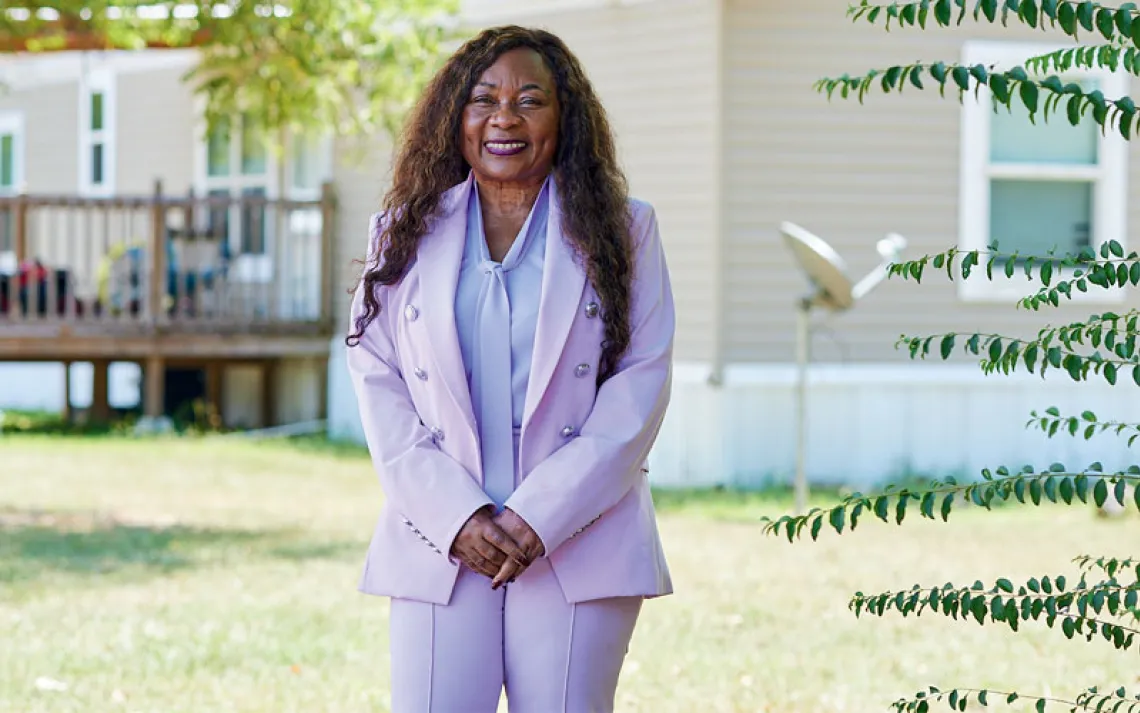Refusing to Bend
The children of Central California farmworkers have launched a ground-level battle against agribusiness.
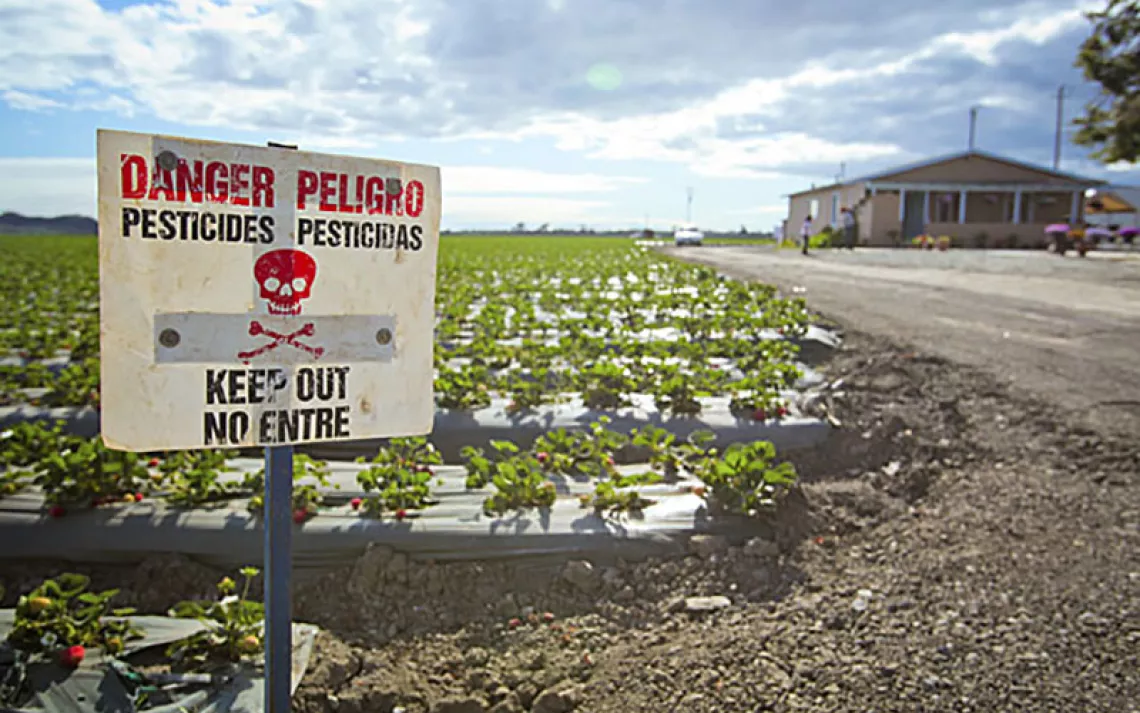
Warning signs bearing a skull and crossbones border the strawberry fields adjacent to the Rios family's home in Watsonville, California. | Photos by Rowan Byers
IT'S A SHORT WALK—ABOUT FIVE OR SIX STEPS—FROM THE NEAT AND COZY KITCHEN of Carolina Rios's family home to the edge of the strawberry fields that serve as her backyard. On a calm Monday evening in April, Carolina's father, Sabino, stands between two rows, his crisp white sweatshirt blending with the mist hanging over the farm.
Bending down, he places a ripe berry between two fingers and, with a flick of the wrist and a firm yank, plucks it from the plant. That's the best way to pick a strawberry, he says. Sabino would know. He and his wife have been piscadores, or strawberry pickers, for 20 years, since emigrating here to Watsonville, California, from Mexico.
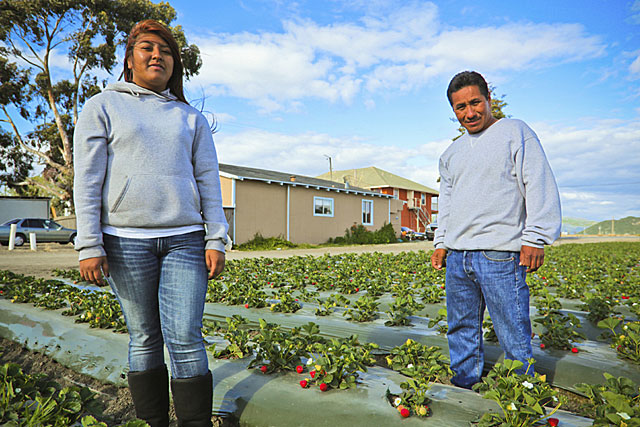
Seventeen-year-old activist Carolina stands in the fields with her father, Sabino, who has been a piscadore, or strawberry picker, for 20 years.
The berry that Sabino has picked in his demonstration is of a certain type: fresas chiquititas, he calls them. Small strawberries. They're small because the fields in which they grow are too close to the family's home to be treated with certain pesticides.
Sabino points to other fields visible from where he stands.
"Fresas más grande pero más peligroso," he says. "Bigger strawberries, but more dangerous."
Sabino and his wife have long known that the pesticides routinely sprayed where they live and work are potentially toxic. It's why they wash their work clothes separately from their children's clothes. However, they recently learned that a new fumigant approved for use in California may present an even greater threat to their family's health. They have their daughter to thank for that.
"When I came home from school and told them about it, it was the first time they had heard of methyl iodide," 17-year-old Carolina explains. Her parents nod in agreement.
In December 2010, the California Department of Pesticide Regulation (DPR) approved methyl iodide for use in the state. This despite fierce and ongoing opposition from scientists, environmental advocacy groups, and agricultural communities, who say methyl iodide poses a danger to farmworkers and residents—though not to consumers, since this particular fumigant degrades long before it can leave residue on a crop. Meanwhile, the manufacturer, Arysta LifeScience, insists it's safe.

The rows of strawberries visible from the Rios family's kitchen window are too close to their home to be treated with certain pesticides.
For Carolina and her peers, there's no debate. They believe that if methyl iodide is used in their community, it will end up in the groundwater they drink, in the air that dries their laundry, and on the boots that their parents wear home from the fields.
In the months since methyl iodide's approval, no growers in the Watsonville or neighboring Salinas area have applied for the permit to use the pesticide. These young activists have had something to do with that. And they intend to keep it that way.
"My house is literally surrounded by the fields," Carolina says frankly. "We're doing this to protect our homes and our families."
* * *
THANKS TO A MEDITERRANEAN CLIMATE AND A NEAR-CONSTANT MARINE LAYER, Watsonville and Salinas produced nearly 90 million trays of strawberries last year—roughly half of California's $2.3 billion strawberry industry. Central Coast berries can be found in produce aisles in New Jersey, Tokyo, and Mexico almost year-round.
Strawberries are a high-value crop, but growing them is a risky business. An unproductive acre (wiped out by a soil-borne pathogen, for instance) can mean a loss of tens of thousands of dollars. To avoid this, growers have routinely applied methyl bromide on their fields, a soil fumigant used prior to planting that essentially renders the soil—once teeming with nematodes and microbes—lifeless, good only for supporting crops.
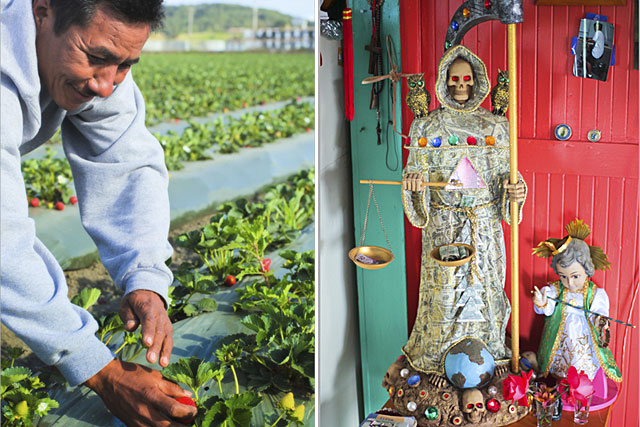
Left: The neighboring Central Coast towns of Watsonville and Salinas, where Sabino and his wife work, produced nearly 90 million trays of strawberries last year, roughly half of California's total output. Right: A tribute to el Santo de Los Muertos, or the Saint of the Dead, sits in the Rios family's living room.
Although applying methyl bromide is beneficial for strawberry growers' bottom line, it isn't so great for the ozone layer. Thus, in the late 1980s, 196 nations signed the Montreal Protocol, agreeing to phase out the use of ozone depletors such as methyl bromide as soon as a suitable alternative was developed.
Methyl iodide is that alternative. The Environmental Protection Agency gave it federal approval in 2007, but the State of California required a separate review process. The DPR approved it late last year after what the agency called the "most extensive evaluation [of a chemical] in the department's history," imposing regulations much stricter than the EPA's.

Sign up to receive Sierra News & Views
Get articles like this one sent directly to your inbox weekly.
With this action you affirm you want to receive Sierra Club communications and may vote on policy designated by the Sierra Club Board.
Impenetrable tarps, limited application rates, wide buffer zones, certified applicators, mandatory permits—these are some of the stringent conditions the DPR set for the fumigant. The agency set the acceptable level of exposure for a farmworker at 96 parts per billion, which is 120 times higher than the level recommended by its own toxicologists. DPR officials maintain that this level, along with the required precautions, means methyl iodide can be used "without exposing workers, the public and environment to harmful levels."
Airborne transmission, groundwater accumulation, developmental effects, thyroid disruption, cancer—these are some of the potential consequences that led an independent scientific review committee, commissioned by the DPR prior to its approval of methyl iodide, to conclude that "there is little doubt that the compound possesses significant toxicity" and would thus result in an "adverse impact on the public health." Committee chair John Froines went even further, saying there is "no safe level of release" for the chemical.
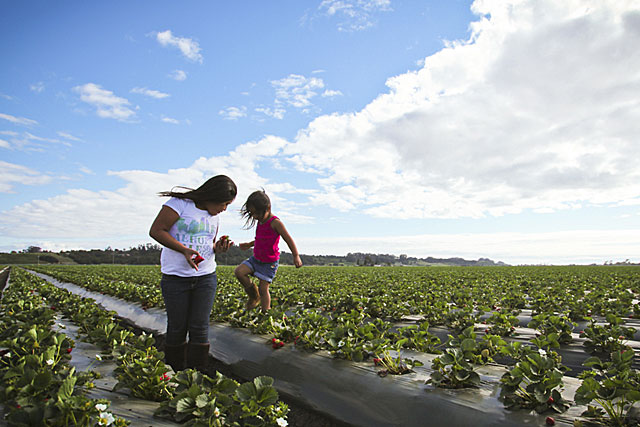
Carolina's younger sisters play in the fields that are just steps away from their front door; the girls know not to eat any strawberries without washing them first.
Arysta LifeScience says that no incidences of methyl iodide-caused illness have been reported in the handful of states where the chemical is currently being used. Devika Ghai of Pesticide Action Network says that claim is misleading. The most damaging health effects, Ghai notes, will likely surface years from now, after prolonged exposure to low doses. "It's all very well to say 'no negative health effects reported,' but 'no data' does not mean no effects," she says. "The truth is more complex and, unfortunately, more ugly."
To date, the opposition to DPR's registration of the chemical has been enough to warrant reconsiderations at both the federal and state level. The EPA opened a second public comment period, and California governor Jerry Brown resolved to take "a fresh look" at registration of the chemical. Permits to apply methyl iodide are currently available, though only one grower has used the chemical in California. However, activists across the state are trying to persuade the governor, via lawsuits and grassroots efforts, to reverse the DPR's approval.
* * *
SITTING AT THEIR LUNCH TABLE AT WATSONVILLE'S RENAISSANCE HIGH SCHOOL on a bright Tuesday morning, Carolina and her close friend Joanna "Jojo" Magdalena talk about things you would expect to hear from high school seniors—homework deadlines, graduation, summer jobs. While both girls seem shy, their actions over the past few months have been anything but.
Like Carolina's home, her school is surrounded by agricultural lands. At most schools, it's cool to be an athlete or a dancer or a debater. These days at Renaissance, it's cool to be an activist.
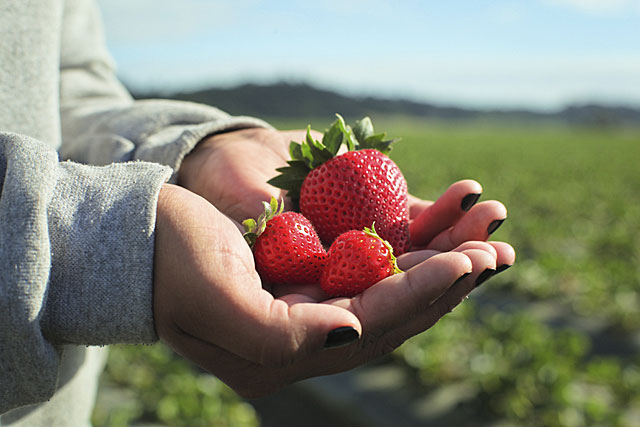
Fresas más grande pero más peligroso,' says Sabino of the strawberries that are grown farther away from his home: Bigger strawberries but more dangerous.'
The girls pick disapprovingly at lifeless hamburgers wrapped in foil, a product of the subsidized free-lunch program, which most students at the school dislike and, of course, are trying to change.
On paper, Renaissance appears an unlikely breeding ground for student-led activism. A continuation high school, it's a place for students who have fallen behind or struggled at other schools. Many of its 200 students, 95 percent of whom are Hispanic, attend only briefly, hoping to get caught up on credits, or as a last chance to earn a diploma. More than 75 percent come from homes that qualify as low income.
A walk around campus though, reveals a high level of engagement. Students are eager to tell visitors about things like the hip-hop chess federation, which blends music, chess, and martial arts to promote nonviolence and positive life skills. Others cook stir-fry with the harvest from the school's garden. One young man talks enthusiastically about the new dance crew he's organizing.
And then there's the political activism, at the center of which is an English teacher named Jenn Laskin, who invokes the phrase "sí, se puede" ("yes, you can") with unrelenting frequency. Laskin's ability to motivate young people appears innate as she walks through campus casually conversing with students at lunchtime.
"Be the lawyer in the boardroom who is suing Monsanto," she tells young activists, "not the hippie in the street who's protesting against it."
Jenn, as her students call her, hates it when Watsonville youths end up in the prison system for minor offenses. She hates it when her students get caught in the "linguistic middle ground" of no Spanish at school and no English at home. And she hates that eight schools in the district are surrounded by agricultural land that's regularly doused with pesticides.
At the lunch table, Carolina and Jojo explain that their first awareness of methyl iodide came from an extra-credit opportunity offered by Laskin: They attended a community forum about the chemical sponsored by the Watsonville Brown Berets, an activist group whose members fight for the "liberation and amelioration of [their] barrios."
"At this meeting we got mad and decided this was a serious problem, so we formed a school club," says Jojo, whose mother works in the strawberry industry.
"Renaissance is in the middle of fields, so it was pretty easy to get everyone to sign the petition."
After getting their schoolmates on their side, Carolina and Jojo, with the help of the Brown Berets and other community groups, went further. They made anti–methyl iodide presentations to the school board, the Watsonville City Council, and the mayor, all of whom adopted formal resolutions against the fumigant. They handed out bilingual flyers at the Friday mercado, got campesinos to sign their petition, and talked about the health risks to their moms, dads, brothers, sisters, tias, and tíos—anyone who would listen.
Carolina and Jojo were well on their way to embodying Laskin's bold style of activism when they learned a hard lesson. On December 1, the day after the girls' triumphant presentation to the Watsonville City Council, the DPR announced its approval of methyl iodide.
Enthusiasm for the cause lulled at school, Jojo says, as some students felt that all of their work was for nothing. Still, Carolina and Jojo maintained their resolve. "The thing about being an activist," Jojo says, "is that when you get mad, you don't go out there and fight with violence; you go out there and organize."
Laskin is proud of her students' efforts and their growing confidence that's emerging alongside their activism. She says the girls' efforts, and that of other community groups, are one reason why methyl iodide has yet to be used in Watsonville and Salinas.
"If a grower registers to use methyl iodide in Santa Cruz or Monterey County, they will immediately become a target for sustained nonviolent direct action against their company, at their offices, in their fields," Laskin says.
"Everyone will know that this company is planning on using methyl iodide, that they are going against all of these resolutions and public opinion."
Carolina and Jojo may not realize it, but this grassroots activism is part of a larger fight for environmental justice by Latinos. According to a 2008 Sierra Club survey, the first-ever environmental poll to specifically address this community, close to 40 percent of Latinos in the United States have health problems linked to environmental causes.
"This is a community that is most punished by environmental degradation," says Javier Sierra, a Spanish-language columnist for the Sierra Club. "Poor and minority communities are always burdened with the most undesirable places to live because it's much cheaper to set up shop there."
The average salary for a U.S. agricultural worker is roughly $13,000 per year, according to Department of Labor statistics. Strawberry pickers like Sabino receive an hourly wage of about $5—well below the minimum wage—plus $1 for every 8- to 12-pound tray they fill. Both Carolina and Jojo see the harsh economic realities of an agricultural livelihood firsthand. Although Jojo realizes that her mom supports her activism, she also realizes that such support can only go so far.
"Knowing how the financial situation is around here, it's really hard for someone like my mom to acknowledge what's really going on," Jojo says. "On one side, we're trying to take care of our health and safety. But on the other side, we're trying to survive financially."
* * *
WITH WORDS LIKE "CARCINOGEN" AND "NEUROTOXIN" trailing nearly every mention of methyl iodide, you'd think its manufacturer Arysta LifeScience wouldn't be so eager to talk about its product. However, Jeff Tweedy, Arysta's head of business development, seems to be waging a public relations offensive on behalf of the company.
Read a favorable mention of methyl iodide—either in a letter to the editor or in the comments section of an online article—and it's likely been written by Tweedy. Seeking out interviews with journalists, Tweedy combats unfavorable claims of the company's product by citing the chemical's other manifestations.
"Do you know who the largest manufacturer of methyl iodide is?" Tweedy asks in a February interview. "The ocean. . . . It's a naturally occurring substance. Iodide is part of the daily diet. We need it or our thyroid won't function properly."
Tweedy explains that in agricultural use, methyl iodide is combined with water and then applied via drip irrigation. After application, the field is covered with a tarp and, according to the DPR, the chemical "is then allowed to degrade to low levels safe for crop growth," usually for about two weeks.
Tweedy insists that these precautions, along with the DPR restrictions, are sufficient. "We've got stringent stewardship, and we work very hard to make sure people are trained properly," he says. "I believe that if the product is applied per directions, it can be applied safely and we can maintain that urban balance with agriculture."
The problem, according to critics of methyl iodide, is that the people who make and market the pesticide are working, living, and breathing in a very different world from the residents of Watsonville. Arysta's world is a place where tarps stay put, winds don't change direction in the middle of application, and eight-year-old kids always heed the skull and crossbones warning them to stay away from recently fumigated fields.
Watsonville's world is real, full of accidents and unforeseen effects. It's one where a lack of public transportation means that kids cut through the fields on long walks to school. It's one where a portion of residents get their water supply not from pipes but from easily contaminated wells. And it's one where farmworkers don't always know what they're being exposed to at work.
Emmanuel "Manny" Ballesteros is another young activist who works with the Watsonville Brown Berets. He says that growing up in and around the agricultural fields of Watsonville, where pesticide usage has long been the norm, his fear of exposure is a daily reality.
"I hate just going somewhere, wearing my hoodie, and then picking up my little niece when I get home, and then suddenly I'm thinking, 'Did I make her sick?'"
Manny has even more reason to worry about methyl iodide than he did with its chemical predecessor, says Edward Loechler, a molecular biologist at Boston University. Loechler, along with eight other scientists from diverse disciplines, sat on the independent scientific review committee that the DPR commissioned to evaluate the existing science around methyl iodide. He says that because of the chemical's volatility, it's highly likely that it will rise into the air in plumes after being applied to the soil.
"In terms of toxicity, would I want to walk into Room A with methyl bromide or Room B with methyl iodide?" Loechler asks. "I'd walk into the methyl bromide room. Methyl iodide is just more reactive."
The factors that make methyl iodide so effective are the same that make it unsafe, contends Anne Katten, staff scientist with the California Rural Legal Assistance Foundation and a trained industrial hygienist. "There's a double-edge sword with all fumigants," she says. "They need to be highly volatile and toxic to work and are applied at high concentrations, compared to other pesticides. But that also makes them harder to control, with more immediate and long-term health effects."
Loechler dismisses Tweedy's comparison of methyl iodide to naturally occurring iodide, which can be found in table salt. "That's not even apples to oranges—it's apples to swing sets," Loechler says. It ignores the obvious fact that "a little bit of something is a good thing, but too much is a bad thing."
Arysta's data is sound, Loechler says; it's the interpretation that's skewed. "A lot of the science Arysta did was well done, and so I don't want to be critical of the data itself," he says. "[But], if a graduate student came to me and interpreted the science the way the Arysta scientists did, I would send them back to third grade."
Because pesticides are the lynchpin of the region's strawberry industry, farming without fumigants such as methyl bromide or methyl iodide would almost certainly mean lower yields, smaller berries, a shorter growing season, and fewer jobs for an already economically stressed community.
Even if large-scale growers adopted more ecologically sound practices—such as integrated cultivation methods and more-resilient crop varieties—production would almost certainly fall. This would probably mean no more strawberries in New Jersey markets in January. But that might not be such a bad thing, argues Steve Gliessman, a farmer and professor emeritus of agro-ecology at the University of California, Santa Cruz, who was a pioneer in developing organic cultivation methods for strawberries.
"The grower and consumer are so separated, they're both being exploited," Gliessman says. "We need to put the 'culture' back into agriculture."
* * *
AFTER A LONG DAY AT WORK, SABINO SITS WITH HIS FAMILY at the kitchen table, the smell of the evening's finished dinner still lingering in the air. His three-year-old daughter hangs from his neck with that look of adoration that little girls only have for their dads.
Sabino explains that he doesn't like working with chemicals that are harmful to his kids and himself, but says that he has little choice. He needs the work. When asked if he would ever sign a petition against methyl iodide, he immediately says yes—as long as he would be able to do it after work hours or on his lunch break. He wouldn't sign it on company time. He wouldn't want to risk getting fired.
If he did get fired, he says that he would go work somewhere else, maybe with lettuce or broccoli. But he's well aware that pesticides would be used on those fields too. If he had the opportunity to work on a rancho orgánico, he would take it, but he says there just aren't enough of those around.
Sabino does this hard work so his children won't have to. "I really don't want my kids to work bent over all day," Sabino says in Spanish. "They have to study so they won't have to pick berries."
If Carolina ever did end up working as a farmhand, he jokes, she should pick raspberries, because at least they grow on stalks and not the ground. Carolina laughs at the prospect. She doesn't plan on a life of agricultural work. She plans to go to college to study sociology.
In Spanish, the verb agachar, "to bend over," has two meanings: to physically lower oneself to the ground, and to lower oneself before power. So far, much to her parents' delight, Carolina has done neither.
 The Magazine of The Sierra Club
The Magazine of The Sierra Club
